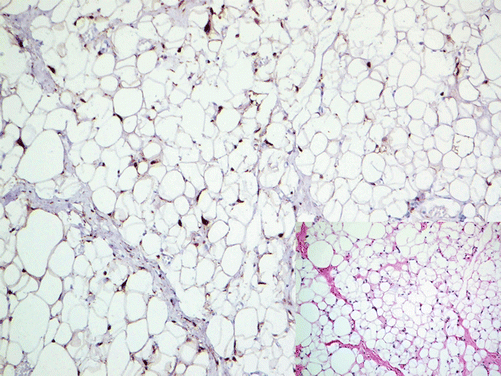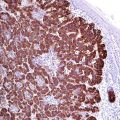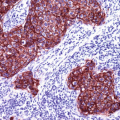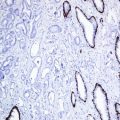, Hans Guski2 and Glen Kristiansen3
(1)
Carl-Thiem-Klinikum, Institut für Pathologie, Cottbus, Germany
(2)
Vivantes Klinikum Neukölln, Institut für Pathologie, Berlin, Germany
(3)
Universität Bonn, UKB, Institut für Pathologie, Bonn, Germany
MDM2 | ||
|---|---|---|
Expression pattern: nuclear/cytoplasmic | ||
Main diagnostic use | Expression in other tumors | Expression in normal cells |
Liposarcoma | Clear cell sarcoma, desmoplastic small round cell tumor, angiosarcoma, Kaposi’s sarcoma, epithelioid sarcoma, embryonal rhabdomyosarcoma, leiomyosarcoma, MPNST, adrenal oncocytoma, osteosarcoma, various carcinomas | Wide variety of epithelia, spermatogenesis, lymphocytes |
Positive control: liposarcoma | ||
Diagnostic Approach
MDM2 (murine double minute 2, also known as E3 ubiquitin-protein ligase) is a nuclear phosphoprotein enzyme that interacts with p53 affecting the cell cycle and apoptosis. MDM2 is overexpressed in many tumors, while the main diagnostic use is to differentiate between benign adipocytic tumors and well-differentiated liposarcoma (Fig. 25.1) [3–5].
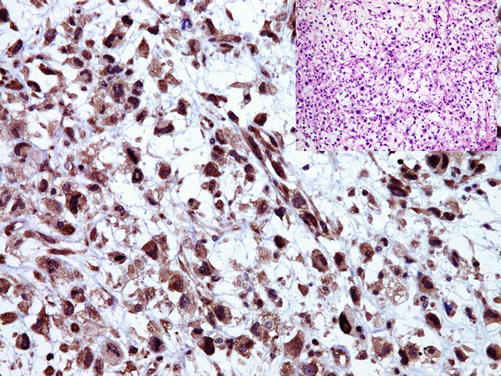

Fig. 25.1
MDM2 expression in neoplastic cells of dedifferentiated liposarcoma
The overexpression of MDM2 is also noted in osteosarcoma but absent in benign fibro-osseous lesions, which can be helpful to discriminate between the two identities.
Diagnostic Pitfalls
As abovementioned, the expression or overexpression of MDM2 might be found in many sarcoma types, which must be considered in the differential diagnosis. It is also important to mention that the clone SMP14 of the MDM2 antibody shows cross-reactivity with some cytokeratins including the cytokeratins 6, 14, and 16, which label squamous epithelium and squamous cell carcinoma.
CDK4:
CDK4 (cyclin-dependent kinase 4) is nuclear enzyme involved in the regulation of the cell cycle. CDK4 is normally expressed in different types of normal and neoplastic cells but overexpressed in some epithelial and mesenchymal tumors. The overexpression of CDK4 is found in liposarcoma, osteosarcoma, and a subset of malignant peripheral nerve sheath tumor in addition to rhabdomyosarcoma; accordingly, CDK4 can be used to discriminate these malignant tumors from benign lesions with similar morphology such as benign lipomatous tumors, benign fibro-osseous lesions, schwannoma, and neurofibromas. CDK4 is also markedly expressed in malignant melanomas, gliomas, and different gastrointestinal, lung, ovarian, and breast carcinomas.
p16:
p16 (cyclin-dependent kinase inhibitor 2A) is a tumor suppressor protein expressed in few carcinoma types and HPV-associated squamous cell carcinoma of different origin. P16 is a helpful marker to distinguish between well-differentiated and dedifferentiated liposarcoma positive for p16 and benign lipoma and normal fatty tissue negative for p16 (Figs. 25.2 and 25.3) [6, 7].

